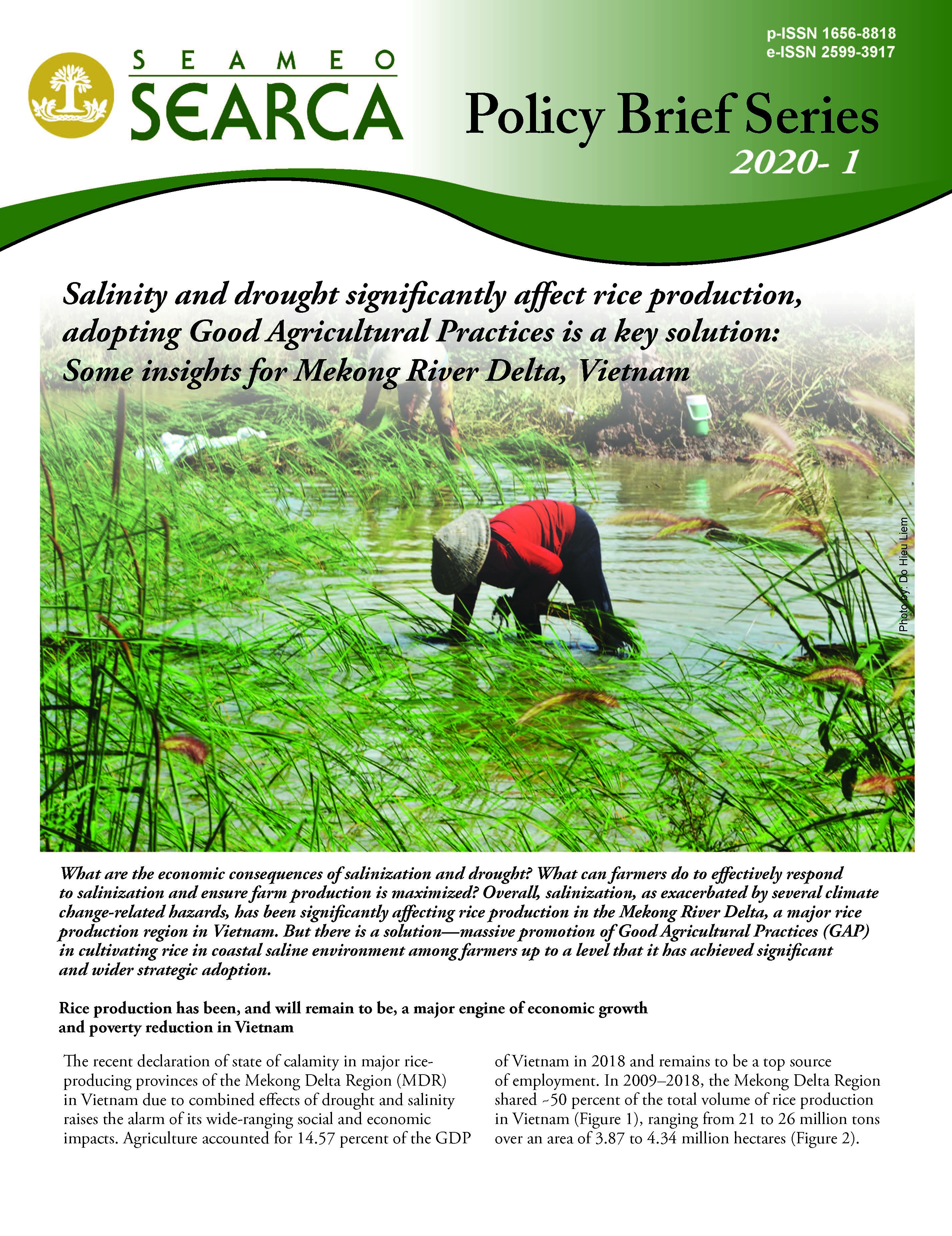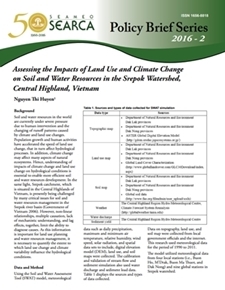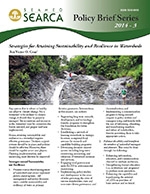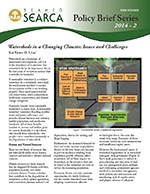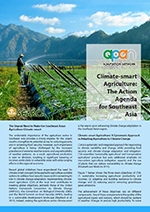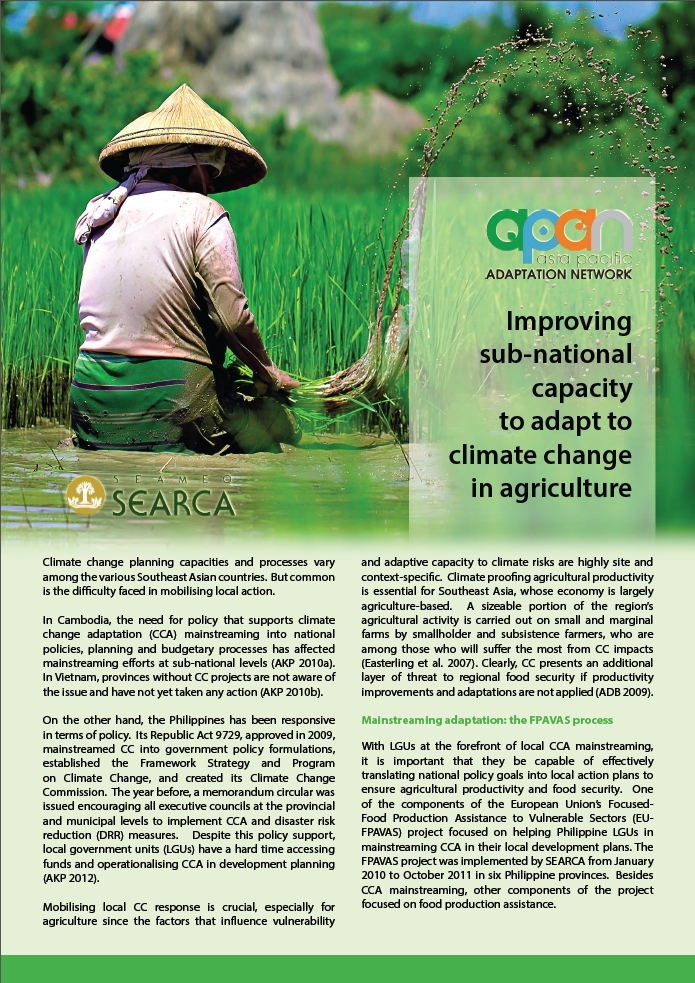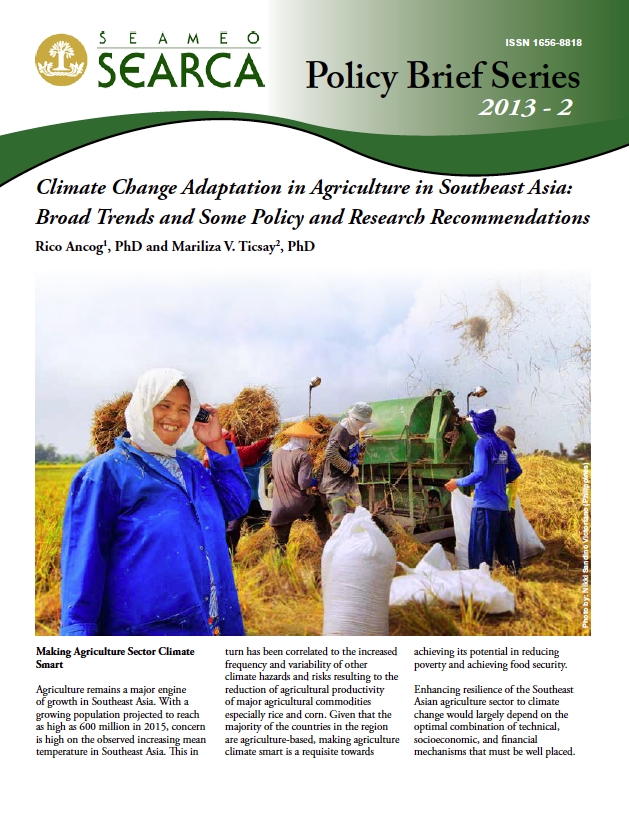Policy Briefs
What are the economic consequences of drought and salinization? What can farmers do to effectively respond to salinization and ensure farm production is maximized? Overall, salinization, as exacerbated by several climate change-related hazards, has been significantly affecting rice production in the Mekong River Delta, a major rice production region in Vietnam. But there is a solution—massive promotion of Good Agricultural Practices (GAP) in cultivating rice in coastal saline environment among farmers up to a level that it has achieved significant…
School gardening has been increasingly popular in the past decade both in developed and developing countries. However, most school gardening projects focus on educational goals and aim to increase school children's knowledge of food systems and their acceptance of vegetable consumption. The School-Plus-Home Gardens Project (S+HGP), a collaboration among the Southeast Asian Regional Center for Graduate Study and Research in Agriculture (SEARCA), the University of the Philippines Los Baños (UPLB), and the Department of Education (DepEd) of the Philippines, district…
Flooding has increased in frequency in various parts of the country, causing damage to thousands of households every year. It directly affects communities through damage to livelihood and properties, loss of earning, and health hazards. Households dependent on agriculture for livelihood are particularly vulnerable because of the negative impact of flooding to productivity. Damage assessments following flood events are regularly done to determine extent of loss and to identify critical areas for intervention. However, these are often macroscale assessments, which do not necessarily generate information that could be useful for policymaking. At the municipal…
Soil and water resources in the world are currently under severe pressure due to human intervention and the changing of runoff patterns caused by climate and land use changes. Population growth and human activities have accelerated the speed of land use change, that in turn affect hydrological processes. In addition, climate change may affect many aspects of natural ecosystems. Hence, understanding of impacts of climate change and land use change on hydrological conditions is essential to enable more efficient soil…
Agriculture is a key sector providing economic and social development in Southeast Asian countries, where a majority of the region’s population depend on agricultural production as a main source of household income. The implication of global environmental change has extended the agricultural agenda to respond to the drivers of climate change—in the context where agriculture is both a contributor to greenhouse gas (GHG) emissions and a possible mitigating factor through the adjustment of practices and the adoption of new technologies.
Any system that is robust or healthy can adapt to climate change. For a watershed to be resilient to a climate change, it should thus be properly managed. The ecosystems and resources in the watershed must be conserve, the forests restores, and proper land uses implemented. Hence, attaining sustainability and resilience in a watershed requires effective governance. Decision support systems should be in place, and policues should be effective. Moreover, there should be capable actors and players. Planning, implementation, and…
Watershed are landscape of interconnected ecosystems that provide a vast array of ecosystem services. A sustainable watershed is a resilient watershed. In A sustainable watershed, the mechanisms involved to sustain the ecosystems within it are working properly. These mechanisms include soil conservation, water conservation, biodiversity conservation, and climate change mitigation.
The undeniable importance of the agriculture sector in Southeast Asia provides a strong impetus for the urgent need to strengthen its potential as key for reducing poverty and in achieving food security. However, such importance of agriculture is being challenged by the increased prevalence of extreme weather events and unpredictability of weather patterns. As a result, agricultural production is seen to diminish resulting to significant lowering of incomes, particularly in vulnerable areas, with wide-ranging effects to the regional economy.
Climate change planning capacities and processes vary among the various Southeast Asian countries. But common is the difficulty faced in mobilising local action. In Cambodia, the need for policy that supports climate change adaptation (CCA) mainstreaming into national policies, planning, and budgetary processes has affected mainstreaming efforts at sub-national levels (AKP 2010a). In Vietnam, provinces without CC projects are not aware of the issue and have not yet taken any action (AKP 2010b). On the other hand, the Philippines has…
Making Agriculture Sector Climate Smart Agriculture remains a major engine of growth in Southeast Asia. With a growing population projected to reach as high as 600 million in 2015, concern is high on the observed increasing mean temperature in Southeast Asia. This, in turn, has been correlated to the increased frequency and variability of other climate hazards and risks resulting to the reduction of agricultural productivity of major agricultural commodities especially rice and corn. Given that the majority of the countries in the region are agriculture-based, making agriculture climate-smart is a requisite towards achieving its…
Page 1 of 2
- 1
- 2

